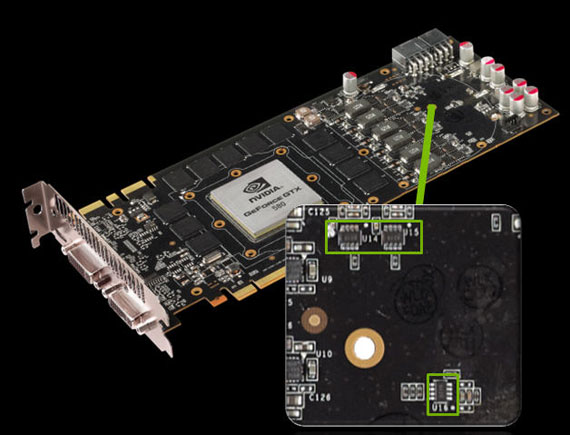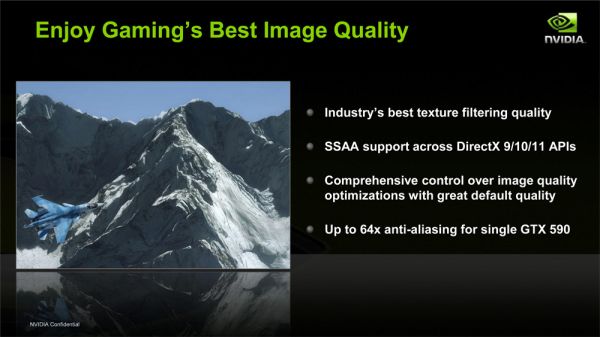NVIDIA’s GeForce GTX 590: Duking It Out For The Single Card King
by Ryan Smith on March 24, 2011 9:00 AM ESTOCP Refined, A Word On Marketing, & The Test
As you may recall from our GTX 580 launch article, NVIDIA added a rudimentary OverCurrent Protection (OCP) feature to the GTX 500 series. At the time of the GTX 580 launch, OCP would clamp down on Furmark and OCCT keep those programs from performing at full speed, as the load they generated was so high that it risked damaging the card. As a matter of principle we have been disabling OCP in all of our tests up until now as OCP was only targeting Furmark and OCCT, meaning it didn’t provide any real protection for the card in any other situations. Our advice to NVIDIA at the time was to expand it to cover the hardware at a generic level, similar to how AMD’s PowerTune operates.

We’re glad to report that NVIDIA has taken up at least some of our advice, and that OCP is taking its first step forward since then. Starting with the ForceWare 267 series drivers, NVIDIA is now using OCP at all times, meaning OCP now protects against any possible program that would generate an excessive load (as defined by NVIDIA), and not just Furmark and OCCT. At this time there’s definitely still a driver component involved as NVIDIA still throttles Furmark and OCCT right off the bat, but everything else seems to be covered by their generic detection methods.
At this point our biggest complaint is that OCP’s operation is still not transparent to the end user. If you trigger it you have no way of knowing unless you know how the game/application should already be performing. NVIDIA tells us that at some point this will be exposed through NVIDIA’s driver API, but today is not that day. Along those lines, at least in the case of Furmark and OCCT OCP still throttles to an excessive degree—whereas AMD gets this right and caps anything and everything at the PowerTune limit, we still see OCP heavily clamp these programs to the point that our GTX 590 draws 100W more under games than it does under Furmark. Clamping down on a program to bring power consumption down to safe levels is a good idea, but clamping down beyond that just hurts the user and we hope to see NVIDIA change this.
Finally, the expansion of OCP’s capabilities is going to have an impact on overclocking. As with reporting when OCP is active, NVIDIA isn’t being fully transparent here so there’s a bit of feeling around at the moment. The OCP limit for any card is roughly 25% higher than the official TDP, so in the case of the GTX 590 this would translate into a 450W limit. This limit cannot currently be changed by the end user, so overclocking—particularly overvolting—risks triggering OCP. Depending on how well its generic detection mode works, it may limit extreme overclocking on all NVIDIA cards with the OCP hardware at the moment. Even in our own overclock testing we have some results that may be compromised by OCP, so it’s definitely something that needs to be considered.
Moving on, I’d like to hit upon marketing quickly. Normally the intended market and uses of most video cards is rather straightforward. For the 6990 AMD pushed raw performance Eyefinity (particularly 5x1P), while for the GTX 590 NVIDIA is pushing raw performance, 3D Vision Surround, and PhysX (even if dedicating a GF110 to PhysX is overkill). However every now and then something comes across that catches my eye. In this case NVIDIA is also using the GTX 590 to reiterate their support for SuperSample Anti-Aliasing support for DX9, DX10, and DX11. SSAA is easily the best hidden feature of the GTX 400/500 series, and it’s one that doesn’t get much marketing attention from NVIDIA. So it’s good to see it getting some attention from NVIDIA—certainly there’s no card better suited for it than the GTX 590.
Last, but not least, we have the test. For the launch of the GTX 590 NVIDIA is providing us with ForceWare 267.71 beta, which adds support for the GTX 590; there are no other significant changes. For cooling purposes we have removed the case fan behind PEG1 on our test rig—while an 11” card is short enough to fit it, it’s counterproductive for a dual-exhaust design. Finally, in order to better compare the GTX 590 to the 6990’s OC/Uber mode, we’ve given our GTX 590 a slight overclock. Our GTX 590 OC is clocked at 750/900, a 143MHz (23%) core and 47MHz (5%) memory overclock. Meanwhile the core voltage was raised from 0.912v to 0.987v. With the poor transparency of OCP’s operation however, we are not 100% confident that we haven’t triggered OCP, so please keep that in mind when looking at the overclocked results.
Update: April 2nd, 2011: Starting with the 267.91 drivers and release 270 drivers, NVIDIA has disabled overvolting on the GTX 590 entirely. This is likely a consequence of several highly-publicized incidents where GTX 590 cards died as a result of overvolting. Although it's unusual to see a card designed to not be overclockable, clearly this is where NVIDIA intends to be.
As an editorial matter we never remove anything from a published article so our GTX 590 OC results will remain. However with these newer drivers it is simply not possible to attain them.
| CPU: | Intel Core i7-920 @ 3.33GHz |
| Motherboard: | Asus Rampage II Extreme |
| Chipset Drivers: | Intel 9.1.1.1015 (Intel) |
| Hard Disk: | OCZ Summit (120GB) |
| Memory: | Patriot Viper DDR3-1333 3x2GB (7-7-7-20) |
| Video Cards: |
AMD Radeon HD 6990 AMD Radeon HD 6970 AMD Radeon HD 6950 2GB AMD Radeon HD 6870 AMD Radeon HD 6850 AMD Radeon HD 5970 AMD Radeon HD 5870 AMD Radeon HD 5850 AMD Radeon HD 5770 AMD Radeon HD 4870X2 AMD Radeon HD 4870 EVGA GeForce GTX 590 Classified NVIDIA GeForce GTX 580 NVIDIA GeForce GTX 570 NVIDIA GeForce GTX 560 Ti NVIDIA GeForce GTX 480 NVIDIA GeForce GTX 470 NVIDIA GeForce GTX 460 1GB NVIDIA GeForce GTX 460 768MB NVIDIA GeForce GTS 450 NVIDIA GeForce GTX 295 NVIDIA GeForce GTX 285 NVIDIA GeForce GTX 260 Core 216 |
| Video Drivers: |
NVIDIA ForceWare 262.99 NVIDIA ForceWare 266.56 Beta NVIDIA ForceWare 266.58 NVIDIA ForceWare 267.71 AMD Catalyst 10.10e AMD Catalyst 11.1a Hotfix AMD Catalyst 11.4 Preview |
| OS: | Windows 7 Ultimate 64-bit |











123 Comments
View All Comments
valenti - Thursday, March 24, 2011 - link
Ryan, I commented last week on the 550 review. Just to echo that comment here: how are you getting the "nodes per day" numbers? Have you considered switching to a points per day metric? Very few people can explain what nodes per day are, and they aren't a very good measure for real world folding performance.(also, it seems like you should double the number for this review, since I'm guessing it was just ignoring the second GPU)
Ryan Smith - Thursday, March 24, 2011 - link
Last year NVIDIA worked with the F@H group to provide a special version of the client for benchmark purposes. Nodes per day is how the client reports its results. Since points are arbitrary based on how the F@H group is scoring things, I can't really make a conversion.poohbear - Thursday, March 24, 2011 - link
Good to see that a $700 finally has a decent cooler! Why would somebody spend $700 & then go and hafta spend another $40 for an aftermarket cooler??? nvidia & AMD really need to just charge $750 and hve an ultra quiet card, these people in this price range are'nt gonna squabble over an extra $50 for petes sake!!!! it makes no sense that they skimp on the cooler at this price range! this is the top of the line where money isnt the issue!Guspaz - Thursday, March 24, 2011 - link
Let's get this straight, nVidia. Slapping two of your existing GPUs together does not make this a "next-generation card". Saying that you've been working on it for two years is also misleading; I doubt it took two years just to lay out the PCB to get two GPUs on a single board.SLI and Crossfire still feel like kludges. Take Crysis 2 for example. The game comes out, and I try to play it on my 295. It runs, but only on one GPU. So I go looking online; it turns out that there's an SLI profile update for the game, but only for the latest beta drivers. If you install those drivers *and* the profile update, you'll get the speed boost, but also various graphical corruption issues involving flickering of certain types of effects (that seem universal rather than isolated).
After two goes at SLI (first dual 285s, next a 295), I've come to the conclusion that SLI is just not worth the headache. You'll end up dealing with constant compatibility issues.
strikeback03 - Thursday, March 24, 2011 - link
And that is why people still buy the 6970/580, rather than having 2 cheaper cards in SLI like so many recommend.JarredWalton - Thursday, March 24, 2011 - link
For the record, I've had three goes at CrossFire (2 x 3870, 4870X2, and now 2 x 5850). I'm equally disappointed with day-of-release gaming results. But, if you stick to titles that are 2-3 months old, it's a lot better. (Yeah, spend $600 on GPUs just so you can wait two months after a game release before buying....)Guspaz - Friday, March 25, 2011 - link
I don't know about that, the original Crysis still has a lot of issues with SLI.Nentor - Thursday, March 24, 2011 - link
"For the GTX 590 launch, NVIDIA once again sampled partner cards rather than sampling reference cards directly to the press. Even with this, all of the cards launching today are more-or-less reference with a few cosmetic changes, so everything we’re describing here applies to all other GTX 590 cards unless otherwise noted.With that out of the way, the card we were sampled is the EVGA GeForce GTX 590 Classified, a premium GTX 590 offering from EVGA. The important difference from the reference GTX 590 is that GTX 590 Classified ships at slightly higher clocks—630/864 vs. 607/853.5—and comes with a premium package, which we will get into later. The GTX 590 Classified also commands a premium price of $729."
Are we calling overclocked cards "more-or-less reference" cards now? That's a nice way to put it, I'll use it the next time I get stopped by a police officer. Sir, I was going more or less 100mph.
Reference is ONE THING. It is the basis and does not waver. Anything that is not it is either overclocked or underclocked.
strikeback03 - Thursday, March 24, 2011 - link
Bad example, as in the US at least your speedometer is only required to be accurate within 10%, meaning you can't get ticketed at less than 10% over the speed limit. This card is only overclocked by 4%. More importantly, they a) weren't sent a reference card, and b) included full tests at stock clocks. Would you rather they not review it since it isn't a reference card?Nentor - Thursday, March 24, 2011 - link
That is a good point actually, I didn't think of that.Maybe reject the card yes, but that is not going to happen. Nvidia is just showing who is boss by sending a non reference card. AT will have to swallow whatever Nvidia feeds them if they want to keep bringing the news.